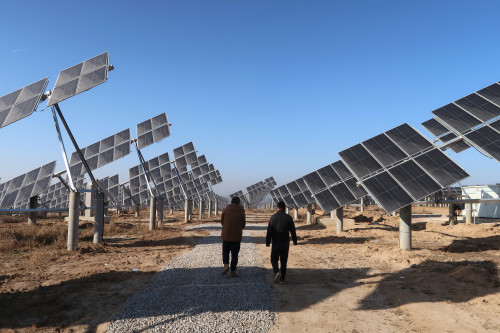By Colleen Howe
BEIJING (Reuters) -China’s new solar power capacity will slow in the second half of 2025 as reforms removing guaranteed pricing create uncertainty for new projects, though full-year additions will still likely reach a record high because of frontloading, analysts say.
Slowing growth in the world’s largest solar fleet is a fresh blow for solar manufacturers already struggling with massive overcapacity and a vicious price war.
Global solar manufacturers, the majority of which are in China, have the capacity to make more than twice the number of panels the world will buy this year, according to an estimate from Morningstar.
Through June, China has added 212 gigawatts of new solar capacity, according to data from the National Energy Administration, more than double the first-half 2024 additions.
But based on that figure, the latest annual forecasts from analysts show that capacity additions are likely to roughly halve in the second half compared to last year.
Analysts at Natixis expect 300 GW of new solar for 2025 in its mid-point scenario. That likely means only 88 GW will be added for the rest of the year, based on calculations deducting the first half NEA data.
Fitch Solutions’ BMI forecasts an annual gain of 310 GW, which would mean an expected gain of only 98 GW for the rest of the year.
NEA data showed 175 GW of solar were added in the second half of 2024, part of a record annual surge of 277 GW.
Power reforms introduced earlier this year removed a guaranteed rate of return for renewable energy projects, forcing projects built from June to sell power at market prices.
The change creates uncertainty around the rate of return for investors accustomed to fixed pricing. Adding to the confusion, the exact market mechanisms can differ between provinces.
Because of this, companies surged their new capacity into the first half of the year, with 93 GW of new additions in May, which dropped to 14 GW in June, the NEA data showed.
“All of the projects were rushing to be commissioned ahead of the last window where they have basically guaranteed revenue,” said Linda Zeng, senior power and renewables analyst for BMI.
She believes annual additions will still be higher “because of the sheer scale of the first half. But we expect for the rest of the months that additions could be at a similar rate as June, which is not super high.”
From 2026, solar installations are forecast to level out around 250 GW per year, said Zeng.
(Reporting by Colleen Howe; Editing by Christian Schmollinger)

